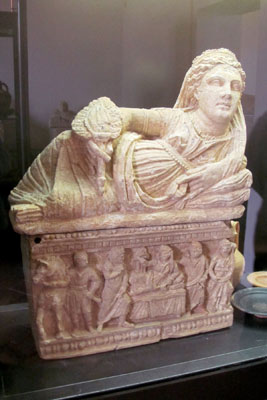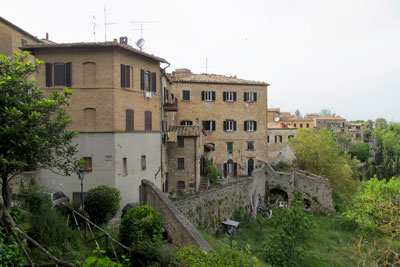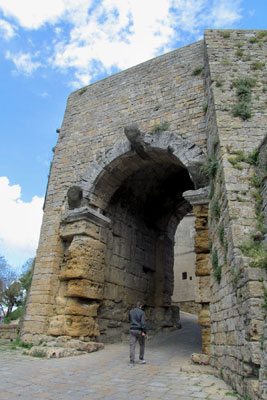Volterra — from Acropolis to necropolis
This item appears on page 62 of the November 2014 issue.
The Etruscans dominated a wide swath of Italy from approximately the eighth century to the fifth century BC. Their territory stretched from the Arno River south to the Tiber, although the boundaries were not rigid and meandered well beyond this area of north-central Italy.
The Etruscans had edged out the indigenous peoples of the areas they occupied until they, themselves, finally were conquered by a stronger neighbor to the south: Rome.
At the height of Etruscan power, there were 12 cities that comprised a loose confederation. Velathri, present-day Volterra, was one of these.
Situated high on a narrow ridge overlooking verdant countryside, about 48 miles southwest of Florence and 46 miles southeast of Pisa, Volterra has shrunk in size since Etruscan times. There still remain large sections of Etruscan walls that encircle the inner medieval walls of a later, smaller city.
I first visited Volterra 10 years ago and have wanted to return ever since to savor this quintessential Etruscan city, to “sip it slowly like a fine wine,” as my husband, Paul, puts it.
The opportunity finally came in May 2014 when we rented an atmospheric and very charming stone house located on the edge of the medieval walls and gave ourselves a week to explore Volterra. No running around to the many other nearby tempting Tuscan hill towns. Just Volterra.
Etruscan Acropolis
We began our exploration of Volterra at the top on what was once the Acropolis of Etruscan Velathri. Perched at the highest point of the ridge, the Acropolis is where the Velathri Etruscans built two temples to honor their gods. The ruins of these temples can be visited.
When, 2,000 years after the temples were built, the Florentines conquered the city-state of Volterra in 1472, they built a massive stone fortress on this Acropolis for the “protection” of the defeated city not far from the site of the Etruscan temples.
Today the fortress is a maximum-security prison. It can’t be visited inside (unless you know someone in the klink), but you can walk beneath its imposing, almost intimidating walls.
From the Acropolis, it was downhill — literally — to the Porta all’Arco, one of the remaining Etruscan gates of ancient Velathri and once the city’s main entrance.
Parts of this massive gateway are Etruscan, including, supposedly, the extremely weathered heads of three Etruscan gods identified as Uni, Tinia and Menrva (respectively, Juno, Jupiter and Minerva in the Roman pantheon) on the outer side of the gate. The parts that aren’t Etruscan are Roman, but only an archaeologist could tell which is which.
There’s another Etruscan gate at the opposite end of Volterra, beyond the medieval walls. It’s called Portone (Porta Diana is its Roman name), and it leads to Etruscan necropolises lying outside the Etruscan walls.
Etruscan necropolis
The necropolis we visited consisted of a small, grass-covered tumulus inside which were chambers that once held funerary urns similar to those on display in Volterra’s Etruscan Museum. A few steps beyond lie other tumuli and, nearby, stones that once were part of an Etruscan road.
One of the main reasons I wanted to spend a week in Volterra was to have plenty of time to savor the Guarnacci Etruscan Museum, visiting it several times (a few short visits rather than one long, tiring visit). If you like things Etruscan, you will love this museum, located at Via Don Minzoni 15 in the eastern section of Volterra. It ranks as one of the best in the world.
Urn upon urn
In the museum, room after room is filled with Etruscan funerary urns, more than 600 of them. They are rectangular stone coffins with carved reliefs on their front panels and often with carved effigies of the deceased atop the coffin lid. They held the ashes of the deceased.
The urns are arranged in the museum’s rooms by type. There are rooms with urns showing hunting scenes. There are others with urns adorned with mythological scenes. Others show the deceased variously on horseback, aboard a ship, inside a wagon or riding a chariot while bidding a final farewell to family and friends. Although the themes are repetitive, the carvings are not. Each is distinctive and individual.
The most famous of the urns is the Urna degli Sposi (Urn of the Married Couple), realistically depicting an elderly couple lying atop their sarcophagus. Just as famous and not to be missed is Ombra della Sera (Shadow of the Evening), a third-century-BC elongated bronze votive of a young boy.
After the Etruscans
Volterra is blessed with incomparable Etruscan treasures, but there’s more to see from other periods of the city’s long history: the Roman theater from the first century BC, the Duomo (Cathedral) in Pisan-Romanesque style, the atmospheric Piazza dei Priori surrounded by medieval buildings, the Pinacoteca displaying Luca Signorelli’s “Annunciation” (1491) and Rosso Fiorentino’s “Deposition” (1521) and the superb 19th-century Palazzo Viti, in which descendants of the original family still live.
Numerous alabaster shops line Volterra’s main shopping streets — not unusual, since alabaster is mined in the region. There also are workshops where you can watch artisans at work and even an Alabaster Museum adjacent to the Pinacoteca.
There were other hill towns rich in Etruscan treasures that we visited on our month-long trip through Tuscany and Umbria. Orvieto has the Museo Claudio Faina and the National Archaeological Museum, both a few steps away from Orvieto’s glorious cathedral and both displaying Etruscan artifacts.
Cortona’s Museo dell’Accademia Etrusca, housed in the 13th-century Palazzo Casali, displays objects from the Etruscan past. Just outside Cortona is a huge Etruscan tumulus, il Sodo 2, with a unique sixth-century-BC altar projecting out of its side. It’s the only Etruscan tomb yet discovered that still has such an altar in situ.
If you go…
We rented a stone house with a panoramic view of the surrounding Tuscan countryside. Called Alabastro, it had a living/dining room, kitchen, two bedrooms and 1½ bathrooms — all doll-house size and all very lovely. We thought the price a bargain: $1,085 (off-season prices drop by $190 per week).
We rented Alabastro through The Parker Company (Seaport Landing, 152 Lynnway, Lynn, MA 01902; 800/280-2811, fax 781/596-3125, email [email protected] or visit www.parkervillas.com), which also took care of our car rental. The Parker Company has dozens of other properties all over Italy, most of which are in Tuscany and Umbria.





